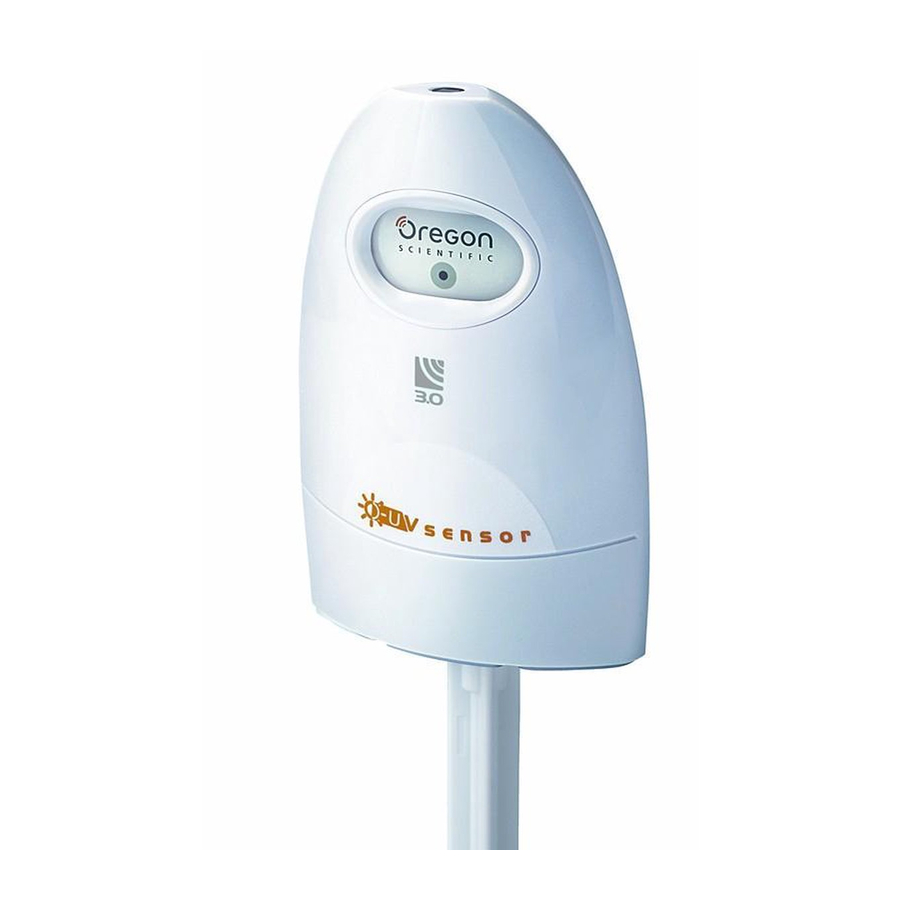
Oregon Scientific UVN800 - UV Sensor Manual
- User manual (2 pages) ,
- User manual (2 pages)
Advertisement

INTRODUCTION
Thank you for selecting the Oregon ScientificTM UV Sensor (UVN800). This sensor is compatible with main units that carry this logo  .
.
Keep this manual handy as you use your new product. It contains practical step-by-step instructions, as well as technical specifications and warnings you should know.
PRODUCT OVERVIEW
FRONT VIEW

- Sensor
- LED indicator
BACK VIEW

- RESET hole
- Connector for stake apparatus
- Battery compartment
GETTING STARTED
The UV sensor measures the UV Index. It transmits data to the main unit every 73 seconds and has a maximum transmission range of 100 metres (330 feet).
SETUP SENSOR
- Insert the batteries as shown.
![Oregon Scientific - UVN800 - SETUP SENSOR - Step 1 SETUP SENSOR - Step 1]()
- Close the battery door and press RESET to turn the sensor on.
- Press the appropriate main unit button (as specified in the main unit manual) to initiate a signal search.
- To place the sensor into the ground, fix the stake into the base of the sensor. Then, insert into the ground up to the level indicator.
![Oregon Scientific - UVN800 - SETUP SENSOR - Step 2 SETUP SENSOR - Step 2]()
- To wall mount, attach the bracket to the sensor and fix to the wall as shown.
![Oregon Scientific - UVN800 - SETUP SENSOR - Step 5 SETUP SENSOR - Step 5]()
NOTE
To get the most accurate readings, place the sensor in a position that has minimum obstructions (i.e. walls and doors) between it and the main unit. The sensor should be placed in an upright position, away from any shade or shadows that may affect how accurate the sensor provides readings.
For best results:
- Do not place the sensor more than 100 m (330 ft) from the main (indoor) unit.
- Position the sensor so that it faces the main (indoor) unit, minimizing obstructions such as doors, walls, and furniture.
- Place the sensor in a location with a clear view to the sky, away from metallic or electronic objects.
- Position the sensor close to the main unit during cold winter months as below-freezing temperatures may affect battery performance and signal transmission.
The transmission range may vary depending on many factors. You may need to experiment with various locations to get the best results.
Standard Alkaline batteries contain significant amounts of water. Because of this they will freeze in low temperatures of approximately -12°C (10°F). Consumer grade Lithium batteries have a much lower threshold for temperature with an estimated freezing range of below -30°C (-22°F).
Wireless ranges can be impacted by a variety of factors such as extremely cold temperatures. Extreme cold may temporarily reduce the effective range between the sensor and the base station. If the unit's performance fails due to low temperature, the unit will resume proper functioning as the temperature rises to within the normal temperature range (i.e. no permanent damage will occur to the unit due to low temperatures).
RESET
To reset the unit, use a thin blunt object to press RESET.
TROUBLESHOOTING
| PROBLEM | SYMPTOM | REMEDY |
| Remote sensor | Cannot locate remote sensor | Check batteries |
| Check location | ||
| Initiate a manual sensor search |
PRECAUTIONS
This product is engineered to give you years of satisfactory service if you handle it carefully. Here are a few precautions:
- Do not subject the unit to excessive force, shock, dust, temperature or humidity, which may result in malfunction, shorter electronic life span, damaged battery and distorted parts.
- Do not immerse the unit in water. If you spill liquid over it, dry it immediately with a soft, lint-free cloth.
- Do not clean the unit with abrasive or corrosive materials.
- Do not tamper with the unit's internal components. Doing so will invalidate the warranty on the unit and may cause unnecessary damage. The unit contains no user-serviceable parts.
- Only use fresh batteries as specified in the user's instructions. Do not mix new and old batteries.
- Due to printing limitations, the displays shown in this manual may differ from the actual display.
- The contents of this manual may not be reproduced without the permission of the manufacturer.
- Do not dispose this product as unsorted municipal waste. Collection of such waste separately for special treatment is necessary.
NOTE
The technical specifications for this product and the contents of the user manual are subject to change without notice.
SPECIFICATION
| W X H x L | 67.7 x 102.5 x 47 mm (2.7 x 4 x 1.9 inches) |
| Weight | 82 g (2.89 ounces) without battery |
| Unit | UV Index |
| Outdoor Range | -20°C to 60°C (-4°F to 140°F) |
| Power | 2 x UM-3 (AA) 1.5V Alkaline batteries |
| Transmission range | 100 metres (330 feet) |
| Transmission Frequency | Every 73 seconds |
ABOUT OREGON SCIENTIFIC
Visit our website (www.oregonscientific.com) to learn more about Oregon Scientific products such as digital cameras; MP3 players; children's electronic learning products and games; projection clocks; health and fitness gear; weather stations; and digital and conference phones. The website also includes contact information for our Customer Care department in case you need to reach us, as well as frequently asked questions and customer downloads.
We hope you will find all the information you need on our website, however if you're in the US and would like to contact the Oregon Scientific Customer Care department directly, please visit: www2.oregonscientific.com/service/default.asp
OR
Call 1-800-853-8883.
For international inquiries, please visit: www2.oregonscientific.com/about/international.asp

Documents / ResourcesDownload manual
Here you can download full pdf version of manual, it may contain additional safety instructions, warranty information, FCC rules, etc.
Advertisement
Thank you! Your question has been received!















Need Assistance?
Do you have a question about the UVN800 that isn't answered in the manual? Leave your question here.